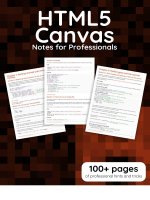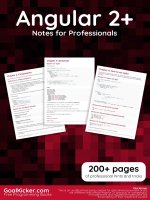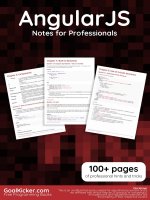AngularJS notes for professionals
Bạn đang xem bản rút gọn của tài liệu. Xem và tải ngay bản đầy đủ của tài liệu tại đây (2.09 MB, 201 trang )
AngularJS
AngularJS
Notes for Professionals
Notes for Professionals
100+ pages
of professional hints and tricks
GoalKicker.com
Free Programming Books
Disclaimer
This is an unocial free book created for educational purposes and is
not aliated with ocial AngularJS group(s) or company(s).
All trademarks and registered trademarks are
the property of their respective owners
Contents
About ................................................................................................................................................................................... 1
Chapter 1: Getting started with AngularJS ...................................................................................................... 2
Section 1.1: Getting Started ........................................................................................................................................... 6
Section 1.2: Showcasing all common Angular constructs ......................................................................................... 7
Section 1.3: The importance of scope .......................................................................................................................... 8
Section 1.4: Minification in Angular ............................................................................................................................ 10
Section 1.5: AngularJS Getting Started Video Tutorials .......................................................................................... 11
Section 1.6: The Simplest Possible Angular Hello World .......................................................................................... 11
Chapter 2: Modules .................................................................................................................................................... 13
Section 2.1: Modules .................................................................................................................................................... 13
Section 2.2: Modules ................................................................................................................................................... 13
Chapter 3: Components ........................................................................................................................................... 15
Section 3.1: Basic Components and LifeCycle Hooks .............................................................................................. 15
Section 3.2: Components In angular JS .................................................................................................................... 17
Chapter 4: Built-in directives ................................................................................................................................ 19
Section 4.1: Angular expressions - Text vs. Number ................................................................................................ 19
Section 4.2: ngIf ........................................................................................................................................................... 19
Section 4.3: ngCloak .................................................................................................................................................... 20
Section 4.4: ngRepeat ................................................................................................................................................. 21
Section 4.5: Built-In Directives Cheat Sheet .............................................................................................................. 24
Section 4.6: ngInclude ................................................................................................................................................. 25
Section 4.7: ng-model-options ................................................................................................................................... 25
Section 4.8: ngCopy .................................................................................................................................................... 26
Section 4.9: ngPaste .................................................................................................................................................... 26
Section 4.10: ngClick .................................................................................................................................................... 27
Section 4.11: ngList ....................................................................................................................................................... 27
Section 4.12: ngOptions ............................................................................................................................................... 28
Section 4.13: ngSrc ....................................................................................................................................................... 30
Section 4.14: ngModel .................................................................................................................................................. 30
Section 4.15: ngClass ................................................................................................................................................... 31
Section 4.16: ngDblclick ............................................................................................................................................... 31
Section 4.17: ngHref ..................................................................................................................................................... 32
Section 4.18: ngPattern ............................................................................................................................................... 32
Section 4.19: ngShow and ngHide .............................................................................................................................. 33
Section 4.20: ngRequired ........................................................................................................................................... 34
Section 4.21: ngMouseenter and ngMouseleave ...................................................................................................... 34
Section 4.22: ngDisabled ............................................................................................................................................ 34
Section 4.23: ngValue .................................................................................................................................................. 35
Chapter 5: Use of in-built directives ................................................................................................................. 36
Section 5.1: Hide/Show HTML Elements .................................................................................................................... 36
Chapter 6: Custom Directives ............................................................................................................................... 37
Section 6.1: Creating and consuming custom directives ......................................................................................... 38
Section 6.2: Directive Definition Object Template ................................................................................................... 39
Section 6.3: How to create resuable component using directive ........................................................................... 40
Section 6.4: Basic Directive example ......................................................................................................................... 42
Section 6.5: Directive decorator ................................................................................................................................. 42
Section 6.6: Basic directive with template and an isolated scope ......................................................................... 43
Section 6.7: Building a reusable component ............................................................................................................ 44
Section 6.8: Directive inheritance and interoperability ............................................................................................ 45
Chapter 7: How data binding works ................................................................................................................. 47
Section 7.1: Data Binding Example ............................................................................................................................ 47
Chapter 8: Angular Project - Directory Structure ..................................................................................... 49
Section 8.1: Directory Structure .................................................................................................................................. 49
Chapter 9: Filters ........................................................................................................................................................ 51
Section 9.1: Accessing a filtered list from outside an ng-repeat ............................................................................ 51
Section 9.2: Custom filter to remove values ............................................................................................................. 51
Section 9.3: Custom filter to format values .............................................................................................................. 51
Section 9.4: Using filters in a controller or service ................................................................................................... 52
Section 9.5: Performing filter in a child array ........................................................................................................... 52
Chapter 10: Custom filters ...................................................................................................................................... 54
Section 10.1: Use a filter in a controller, a service or a filter .................................................................................... 54
Section 10.2: Create a filter with parameters ........................................................................................................... 54
Section 10.3: Simple filter example ............................................................................................................................ 54
Chapter 11: Constants ............................................................................................................................................... 56
Section 11.1: Create your first constant ...................................................................................................................... 56
Section 11.2: Use cases ................................................................................................................................................ 56
Chapter 12: Custom filters with ES6 ................................................................................................................... 58
Section 12.1: FileSize Filter using ES6 .......................................................................................................................... 58
Chapter 13: Directives using ngModelController ........................................................................................ 59
Section 13.1: A simple control: rating .......................................................................................................................... 59
Section 13.2: A couple of complex controls: edit a full object ................................................................................. 61
Chapter 14: Controllers ........................................................................................................................................... 64
Section 14.1: Your First Controller ............................................................................................................................... 64
Section 14.2: Creating Controllers, Minification safe ................................................................................................ 65
Section 14.3: Using ControllerAs in Angular JS ......................................................................................................... 66
Section 14.4: Creating Minification-Safe Angular Controllers ................................................................................. 67
Section 14.5: Creating Controllers .............................................................................................................................. 68
Section 14.6: Nested Controllers ................................................................................................................................. 68
Chapter 15: Controllers with ES6 ......................................................................................................................... 69
Section 15.1: Controller ................................................................................................................................................ 69
Chapter 16: The Self Or This Variable In A Controller .............................................................................. 70
Section 16.1: Understanding The Purpose Of The Self Variable ............................................................................. 70
Chapter 17: Services .................................................................................................................................................. 72
Section 17.1: Creating a service using angular.factory ............................................................................................ 72
Section 17.2: Dierence between Service and Factory ........................................................................................... 72
Section 17.3: $sce - sanitize and render content and resources in templates ...................................................... 75
Section 17.4: How to create a Service ........................................................................................................................ 75
Section 17.5: How to use a service ............................................................................................................................. 76
Section 17.6: How to create a Service with dependencies using 'array syntax' .................................................... 76
Section 17.7: Registering a Service ............................................................................................................................. 77
Chapter 18: Distinguishing Service vs Factory ............................................................................................. 78
Section 18.1: Factory VS Service once-and-for-all ................................................................................................... 78
Chapter 19: Angular promises with $q service ............................................................................................. 80
Section 19.1: Wrap simple value into a promise using $q.when() ........................................................................... 80
Section 19.2: Using angular promises with $q service ............................................................................................. 80
Section 19.3: Using the $q constructor to create promises ..................................................................................... 82
Section 19.4: Avoid the $q Deferred Anti-Pattern ..................................................................................................... 83
Section 19.5: Using $q.all to handle multiple promises ............................................................................................ 84
Section 19.6: Deferring operations using $q.defer ................................................................................................... 85
Chapter 20: Dependency Injection .................................................................................................................... 86
Section 20.1: Dynamic Injections ................................................................................................................................ 86
Section 20.2: Dynamically load AngularJS service in vanilla JavaScript ............................................................. 86
Chapter 21: Events ...................................................................................................................................................... 87
Section 21.1: Using angular event system ................................................................................................................. 87
Section 21.2: Always deregister $rootScope.$on listeners on the scope $destory event .................................... 89
Section 21.3: Uses and significance ........................................................................................................................... 89
Chapter 22: Sharing Data ....................................................................................................................................... 92
Section 22.1: Using ngStorage to share data ........................................................................................................... 92
Section 22.2: Sharing data from one controller to another using service ............................................................ 92
Chapter 23: Form Validation ................................................................................................................................. 94
Section 23.1: Form and Input States .......................................................................................................................... 94
Section 23.2: CSS Classes ........................................................................................................................................... 94
Section 23.3: Basic Form Validation .......................................................................................................................... 94
Section 23.4: Custom Form Validation ...................................................................................................................... 95
Section 23.5: Async validators ................................................................................................................................... 96
Section 23.6: ngMessages .......................................................................................................................................... 96
Section 23.7: Nested Forms ........................................................................................................................................ 97
Chapter 24: Routing using ngRoute ................................................................................................................. 98
Section 24.1: Basic example ........................................................................................................................................ 98
Section 24.2: Defining custom behavior for individual routes ................................................................................ 99
Section 24.3: Route parameters example .............................................................................................................. 100
Chapter 25: ng-class directive ........................................................................................................................... 102
Section 25.1: Three types of ng-class expressions ................................................................................................ 102
Chapter 26: ng-repeat ........................................................................................................................................... 104
Section 26.1: ng-repeat-start + ng-repeat-end ...................................................................................................... 104
Section 26.2: Iterating over object properties ........................................................................................................ 104
Section 26.3: Tracking and Duplicates .................................................................................................................... 105
Chapter 27: ng-style ............................................................................................................................................... 106
Section 27.1: Use of ng-style .................................................................................................................................... 106
Chapter 28: ng-view ................................................................................................................................................ 107
Section 28.1: Registration navigation ...................................................................................................................... 107
Section 28.2: ng-view ................................................................................................................................................ 107
Chapter 29: AngularJS bindings options (`=`, `@`, `&` etc.) .................................................................. 109
Section 29.1: Bind optional attribute ........................................................................................................................ 109
Section 29.2: @ one-way binding, attribute binding ............................................................................................. 109
Section 29.3: = two-way binding .............................................................................................................................. 109
Section 29.4: & function binding, expression binding ............................................................................................ 110
Section 29.5: Available binding through a simple sample .................................................................................... 110
Chapter 30: Providers ............................................................................................................................................ 111
Section 30.1: Provider ................................................................................................................................................ 111
Section 30.2: Factory ................................................................................................................................................ 111
Section 30.3: Constant .............................................................................................................................................. 112
Section 30.4: Service ................................................................................................................................................. 112
Section 30.5: Value .................................................................................................................................................... 113
Chapter 31: Decorators .......................................................................................................................................... 114
Section 31.1: Decorate service, factory .................................................................................................................... 114
Section 31.2: Decorate directive ............................................................................................................................... 114
Section 31.3: Decorate filter ...................................................................................................................................... 115
Chapter 32: Print ....................................................................................................................................................... 116
Section 32.1: Print Service ......................................................................................................................................... 116
Chapter 33: ui-router .............................................................................................................................................. 118
Section 33.1: Basic Example ...................................................................................................................................... 118
Section 33.2: Multiple Views ..................................................................................................................................... 119
Section 33.3: Using resolve functions to load data ................................................................................................ 120
Section 33.4: Nested Views / States ........................................................................................................................ 121
Chapter 34: Built-in helper Functions ............................................................................................................ 123
Section 34.1: angular.equals ..................................................................................................................................... 123
Section 34.2: angular.toJson .................................................................................................................................... 123
Section 34.3: angular.copy ....................................................................................................................................... 124
Section 34.4: angular.isString ................................................................................................................................... 124
Section 34.5: angular.isArray ................................................................................................................................... 124
Section 34.6: angular.merge .................................................................................................................................... 125
Section 34.7: angular.isDefined and angular.isUndefined .................................................................................... 125
Section 34.8: angular.isDate ..................................................................................................................................... 126
Section 34.9: angular.noop ....................................................................................................................................... 126
Section 34.10: angular.isElement .............................................................................................................................. 126
Section 34.11: angular.isFunction .............................................................................................................................. 127
Section 34.12: angular.identity ................................................................................................................................. 127
Section 34.13: angular.forEach ................................................................................................................................. 128
Section 34.14: angular.isNumber .............................................................................................................................. 128
Section 34.15: angular.isObject ................................................................................................................................ 128
Section 34.16: angular.fromJson .............................................................................................................................. 129
Chapter 35: digest loop walkthrough ............................................................................................................ 130
Section 35.1: $digest and $watch ............................................................................................................................. 130
Section 35.2: the $scope tree ................................................................................................................................... 130
Section 35.3: two way data binding ........................................................................................................................ 131
Chapter 36: Angular $scopes .............................................................................................................................. 133
Section 36.1: A function available in the entire app ............................................................................................... 133
Section 36.2: Avoid inheriting primitive values ....................................................................................................... 133
Section 36.3: Basic Example of $scope inheritance ............................................................................................... 134
Section 36.4: How can you limit the scope on a directive and why would you do this? .................................... 134
Section 36.5: Using $scope functions ...................................................................................................................... 135
Section 36.6: Creating custom $scope events ....................................................................................................... 136
Chapter 37: Using AngularJS with TypeScript ........................................................................................... 138
Section 37.1: Using Bundling / Minification ............................................................................................................. 138
Section 37.2: Angular Controllers in Typescript ..................................................................................................... 138
Section 37.3: Using the Controller with ControllerAs Syntax ................................................................................ 140
Section 37.4: Why ControllerAs Syntax? ................................................................................................................. 140
Chapter 38: $http request ................................................................................................................................... 142
Section 38.1: Timing of an $http request ................................................................................................................. 142
Section 38.2: Using $http inside a controller .......................................................................................................... 142
Section 38.3: Using $http request in a service ........................................................................................................ 143
Chapter 39: Prepare for Production - Grunt ............................................................................................... 145
Section 39.1: View preloading ................................................................................................................................... 145
Section 39.2: Script optimisation .............................................................................................................................. 146
Chapter 40: Grunt tasks ....................................................................................................................................... 148
Section 40.1: Run application locally ....................................................................................................................... 148
Chapter 41: Lazy loading ...................................................................................................................................... 151
Section 41.1: Preparing your project for lazy loading ............................................................................................ 151
Section 41.2: Usage ................................................................................................................................................... 151
Section 41.3: Usage with router ................................................................................................................................ 151
Section 41.4: Using dependency injection ............................................................................................................... 152
Section 41.5: Using the directive ............................................................................................................................... 152
Chapter 42: HTTP Interceptor ........................................................................................................................... 153
Section 42.1: Generic httpInterceptor step by step ................................................................................................ 153
Section 42.2: Getting Started ................................................................................................................................... 154
Section 42.3: Flash message on response using http interceptor ....................................................................... 154
Chapter 43: Session storage .............................................................................................................................. 156
Section 43.1: Handling session storage through service using angularjs ............................................................ 156
Chapter 44: Angular MVC .................................................................................................................................... 157
Section 44.1: The Static View with controller .......................................................................................................... 157
Section 44.2: Controller Function Definition ........................................................................................................... 157
Section 44.3: Adding information to the model ..................................................................................................... 157
Chapter 45: SignalR with AngularJS .............................................................................................................. 158
Section 45.1: SignalR and AngularJS [ ChatProject ] ............................................................................................ 158
Chapter 46: Migration to Angular 2+ ............................................................................................................. 162
Section 46.1: Converting your AngularJS app into a componend-oriented structure ....................................... 162
Section 46.2: Introducing Webpack and ES6 modules .......................................................................................... 164
Chapter 47: AngularJS with data filter, pagination etc ....................................................................... 165
Section 47.1: AngularJS display data with filter, pagination ................................................................................. 165
Chapter 48: Profiling and Performance ....................................................................................................... 166
Section 48.1: 7 Simple Performance Improvements .............................................................................................. 166
Section 48.2: Bind Once ............................................................................................................................................ 169
Section 48.3: ng-if vs ng-show ................................................................................................................................. 170
Section 48.4: Watchers ............................................................................................................................................. 170
Section 48.5: Always deregister listeners registered on other scopes other than the current scope .............. 172
Section 48.6: Scope functions and filters ................................................................................................................ 173
Section 48.7: Debounce Your Model ........................................................................................................................ 173
Chapter 49: Performance Profiling ................................................................................................................. 175
Section 49.1: All About Profiling ................................................................................................................................ 175
Chapter 50: Debugging ......................................................................................................................................... 177
Section 50.1: Using ng-inspect chrome extension .................................................................................................. 177
Section 50.2: Getting the Scope of element ........................................................................................................... 179
Section 50.3: Basic debugging in markup .............................................................................................................. 179
Chapter 51: Unit tests ............................................................................................................................................. 181
Section 51.1: Unit test a component (1.5+) ............................................................................................................... 181
Section 51.2: Unit test a filter .................................................................................................................................... 181
Section 51.3: Unit test a service ................................................................................................................................ 182
Section 51.4: Unit test a controller ........................................................................................................................... 183
Section 51.5: Unit test a directive ............................................................................................................................. 183
Chapter 52: AngularJS gotchas and traps .................................................................................................. 185
Section 52.1: Things to do when using html5Mode ................................................................................................ 185
Section 52.2: Two-way data binding stops working ............................................................................................. 186
Section 52.3: 7 Deadly Sins of AngularJS ............................................................................................................... 187
Credits ............................................................................................................................................................................ 191
You may also like ...................................................................................................................................................... 194
About
Please feel free to share this PDF with anyone for free,
latest version of this book can be downloaded from:
/>
This AngularJS Notes for Professionals book is compiled from Stack Overflow
Documentation, the content is written by the beautiful people at Stack Overflow.
Text content is released under Creative Commons BY-SA, see credits at the end
of this book whom contributed to the various chapters. Images may be copyright
of their respective owners unless otherwise specified
This is an unofficial free book created for educational purposes and is not
affiliated with official AngularJS group(s) or company(s) nor Stack Overflow. All
trademarks and registered trademarks are the property of their respective
company owners
The information presented in this book is not guaranteed to be correct nor
accurate, use at your own risk
Please send feedback and corrections to
GoalKicker.com – AngularJS Notes for Professionals
1
Chapter 1: Getting started with AngularJS
Version
1.6.5
Release Date
2017-07-03
1.6.4
2017-03-31
1.6.3
2017-03-08
1.6.2
2017-02-07
1.5.11
2017-01-13
1.6.1
2016-12-23
1.5.10
2016-12-15
1.6.0
2016-12-08
1.6.0-rc.2
2016-11-24
1.5.9
2016-11-24
1.6.0-rc.1
2016-11-21
1.6.0-rc.0
2016-10-26
1.2.32
2016-10-11
1.4.13
2016-10-10
1.2.31
2016-10-10
1.5.8
2016-07-22
1.2.30
2016-07-21
1.5.7
2016-06-15
1.4.12
2016-06-15
1.5.6
2016-05-27
1.4.11
2016-05-27
1.5.5
2016-04-18
1.5.4
2016-04-14
1.5.3
2016-03-25
1.5.2
2016-03-19
1.4.10
2016-03-16
1.5.1
2016-03-16
1.5.0
2016-02-05
1.5.0-rc.2
2016-01-28
1.4.9
2016-01-21
1.5.0-rc.1
2016-01-16
1.5.0-rc.0
2015-12-09
1.4.8
2015-11-20
1.5.0-beta.2 2015-11-18
1.4.7
2015-09-30
1.3.20
2015-09-30
1.2.29
2015-09-30
1.5.0-beta.1 2015-09-30
1.5.0-beta.0 2015-09-17
1.4.6
2015-09-17
1.3.19
2015-09-17
1.4.5
2015-08-28
GoalKicker.com – AngularJS Notes for Professionals
2
1.3.18
2015-08-19
1.4.4
2015-08-13
1.4.3
2015-07-15
1.3.17
2015-07-07
1.4.2
2015-07-07
1.4.1
2015-06-16
1.3.16
2015-06-06
1.4.0
2015-05-27
1.4.0-rc.2
2015-05-12
1.4.0-rc.1
2015-04-24
1.4.0-rc.0
2015-04-10
1.3.15
2015-03-17
1.4.0-beta.6 2015-03-17
1.4.0-beta.5 2015-02-24
1.3.14
2015-02-24
1.4.0-beta.4 2015-02-09
1.3.13
2015-02-09
1.3.12
2015-02-03
1.4.0-beta.3 2015-02-03
1.3.11
2015-01-27
1.4.0-beta.2 2015-01-27
1.4.0-beta.1 2015-01-20
1.3.10
2015-01-20
1.3.9
2015-01-15
1.4.0-beta.0 2015-01-14
1.3.8
2014-12-19
1.2.28
2014-12-16
1.3.7
2014-12-15
1.3.6
2014-12-09
1.3.5
2014-12-02
1.3.4
2014-11-25
1.2.27
2014-11-21
1.3.3
2014-11-18
1.3.2
2014-11-07
1.3.1
2014-10-31
1.3.0
2014-10-14
1.3.0-rc.5
2014-10-09
1.2.26
2014-10-03
1.3.0-rc.4
2014-10-02
1.3.0-rc.3
2014-09-24
1.2.25
2014-09-17
1.3.0-rc.2
2014-09-17
1.2.24
2014-09-10
1.3.0-rc.1
2014-09-10
1.3.0-rc.0
2014-08-30
1.2.23
2014-08-23
GoalKicker.com – AngularJS Notes for Professionals
3
1.3.0-beta.19 2014-08-23
1.2.22
2014-08-12
1.3.0-beta.18 2014-08-12
1.2.21
2014-07-25
1.3.0-beta.17 2014-07-25
1.3.0-beta.16 2014-07-18
1.2.20
2014-07-11
1.3.0-beta.15 2014-07-11
1.2.19
2014-07-01
1.3.0-beta.14 2014-07-01
1.3.0-beta.13 2014-06-16
1.3.0-beta.12 2014-06-14
1.2.18
2014-06-14
1.3.0-beta.11 2014-06-06
1.2.17
2014-06-06
1.3.0-beta.10 2014-05-24
1.3.0-beta.9 2014-05-17
1.3.0-beta.8 2014-05-09
1.3.0-beta.7 2014-04-26
1.3.0-beta.6 2014-04-22
1.2.16
2014-04-04
1.3.0-beta.5 2014-04-04
1.3.0-beta.4 2014-03-28
1.2.15
2014-03-22
1.3.0-beta.3 2014-03-21
1.3.0-beta.2 2014-03-15
1.3.0-beta.1 2014-03-08
1.2.14
2014-03-01
1.2.13
2014-02-15
1.2.12
2014-02-08
1.2.11
2014-02-03
1.2.10
2014-01-25
1.2.9
2014-01-15
1.2.8
2014-01-10
1.2.7
2014-01-03
1.2.6
2013-12-20
1.2.5
2013-12-13
1.2.4
2013-12-06
1.2.3
2013-11-27
1.2.2
2013-11-22
1.2.1
2013-11-15
1.2.0
2013-11-08
1.2.0-rc.3
2013-10-14
1.2.0-rc.2
2013-09-04
1.0.8
2013-08-22
1.2.0rc1
2013-08-13
GoalKicker.com – AngularJS Notes for Professionals
4
1.0.7
2013-05-22
1.1.5
2013-05-22
1.0.6
2013-04-04
1.1.4
2013-04-04
1.0.5
2013-02-20
1.1.3
2013-02-20
1.0.4
2013-01-23
1.1.2
2013-01-23
1.1.1
2012-11-27
1.0.3
2012-11-27
1.1.0
2012-09-04
1.0.2
2012-09-04
1.0.1
2012-06-25
1.0.0
2012-06-14
v1.0.0rc12
2012-06-12
v1.0.0rc11
2012-06-11
v1.0.0rc10
2012-05-24
v1.0.0rc9
2012-05-15
v1.0.0rc8
2012-05-07
v1.0.0rc7
2012-05-01
v1.0.0rc6
2012-04-21
v1.0.0rc5
2012-04-12
v1.0.0rc4
2012-04-05
v1.0.0rc3
2012-03-30
v1.0.0rc2
2012-03-21
g3-v1.0.0rc1 2012-03-14
g3-v1.0.0-rc2 2012-03-16
1.0.0rc1
2012-03-14
0.10.6
2012-01-17
0.10.5
2011-11-08
0.10.4
2011-10-23
0.10.3
2011-10-14
0.10.2
2011-10-08
0.10.1
2011-09-09
0.10.0
2011-09-02
0.9.19
2011-08-21
0.9.18
2011-07-30
0.9.17
2011-06-30
0.9.16
2011-06-08
0.9.15
2011-04-12
0.9.14
2011-04-01
0.9.13
2011-03-14
0.9.12
2011-03-04
0.9.11
2011-02-09
0.9.10
2011-01-27
0.9.9
2011-01-14
GoalKicker.com – AngularJS Notes for Professionals
5
0.9.7
2010-12-11
0.9.6
2010-12-07
0.9.5
2010-11-25
0.9.4
2010-11-19
0.9.3
2010-11-11
0.9.2
2010-11-03
0.9.1
2010-10-27
0.9.0
2010-10-21
Section 1.1: Getting Started
Create a new HTML file and paste the following content:
<!DOCTYPE html>
<html ng-app>
<head>
<title>Hello, Angular</title>
<script src=" /></head>
<body ng-init="name='World'">
<label>Name</label>
<input ng-model="name" />
<span>Hello, {{ name }}!</span>
</body>
</html>
Live demo
When you open the file with a browser, you will see an input field followed by the text Hello, World!. Editing the
value in the input will update the text in real-time, without the need to refresh the whole page.
Explanation:
1. Load the Angular framework from a Content Delivery Network.
<script src=" />
2. Define the HTML document as an Angular application with the ng-app directive
<html ng-app>
3. Initialize the name variable using ng-init
<body ng-init=" name = 'World' ">
Note that ng-init should be used for demonstrative and testing purposes only. When building an actual application,
controllers should initialize the data.
4. Bind data from the model to the view on HTML controls. Bind an <input> to the name property with ng-model
<input ng-model="name" />
GoalKicker.com – AngularJS Notes for Professionals
6
5. Display content from the model using double braces {{ }}
<span>Hello, {{ name }}</span>
6. Another way of binding the name property is using ng-bind instead of handlebars"{{ }}"
<span ng-bind="name"></span>
The last three steps establish the two way data-binding. Changes made to the input update the model, which is
reflected in the view.
There is a difference between using handlebars and ng-bind. If you use handlebars, you might see the actual
Hello, {{name}} as the page loads before the expression is resolved (before the data is loaded) whereas if you use
ng-bind, it will only show the data when the name is resolved. As an alternative the directive ng-cloak can be used
to prevent handlebars to display before it is compiled.
Section 1.2: Showcasing all common Angular constructs
The following example shows common AngularJS constructs in one file:
<!DOCTYPE html>
<html ng-app="myDemoApp">
<head>
<style>.started { background: gold; }</style>
<script src=" /><script>
function MyDataService() {
return {
getWorlds: function getWorlds() {
return ["this world", "another world"];
}
};
}
function DemoController(worldsService) {
var vm = this;
vm.messages = worldsService.getWorlds().map(function(w) {
return "Hello, " + w + "!";
});
}
function startup($rootScope, $window) {
$window.alert("Hello, user! Loading worlds...");
$rootScope.hasStarted = true;
}
angular.module("myDemoApp", [/* module dependencies go here */])
.service("worldsService", [MyDataService])
.controller("demoController", ["worldsService", DemoController])
.config(function() {
console.log('configuring application');
})
.run(["$rootScope", "$window", startup]);
</script>
</head>
<body ng-class="{ 'started': hasStarted }" ng-cloak>
<div ng-controller="demoController as vm">
GoalKicker.com – AngularJS Notes for Professionals
7
<ul>
<li ng-repeat="msg in vm.messages">{{ msg }}</li>
</ul>
</div>
</body>
</html>
Every line of the file is explained below:
Live Demo
1. ng-app="myDemoApp", the ngApp directive that bootstraps the application and tells angular that a DOM
element is controlled by a specific angular.module named "myDemoApp";
2. <script src="angular.min.js"> is the first step in bootstrapping the AngularJS library;
Three functions (MyDataService, DemoController, and startup) are declared, which are used (and explained)
below.
3. angular.module(...) used with an array as the second argument creates a new module. This array is used
to supply a list of module dependencies. In this example we chain calls on the result of the module(...)
function;
4. .service(...) creates an Angular Service and returns the module for chaining;
5. .controller(...) creates an Angular Controller and returns the module for chaining;
6. .config(...) Use this method to register work which needs to be performed on module loading.
7. .run(...) makes sure code is run at startup time and takes an array of items as a parameter. Use this
method to register work which should be performed when the injector is done loading all modules.
the first item is letting Angular know that the startup function requires the built-in $rootScope service
to be injected as an argument;
the second item is letting Angular know that the startup function requires the built-in $window service
to be injected as an argument;
the last item in the array, startup, is the actual function to run on startup;
8. ng-class is the ngClass directive to set a dynamic class, and in this example utilizes hasStarted on the
$rootScope dynamically
9. ng-cloak is a directive to prevent the unrendered Angular html template (e.g. "{{ msg }}") to be briefly
shown before Angular has fully loaded the application.
10. ng-controller is the directive that asks Angular to instantiate a new controller of specific name to
orchestrate that part of the DOM;
11. ng-repeat is the directive to make Angular iterate over a collection and clone a DOM template for each item;
12. {{ msg }} showcases interpolation: on-the-spot rendering of a part of the scope or controller;
Section 1.3: The importance of scope
As Angular uses HTML to extend a web page and plain Javascript to add logic, it makes it easy to create a web page
using ng-app, ng-controller and some built-in directives such as ng-if, ng-repeat, etc. With the new controllerAs
syntax, newcomers to Angular users can attach functions and data to their controller instead of using $scope.
However, sooner or later, it is important to understand what exactly this $scope thing is. It will keep showing up in
GoalKicker.com – AngularJS Notes for Professionals
8
examples so it is important to have some understanding.
The good news is that it is a simple yet powerful concept.
When you create the following:
<div ng-app="myApp">
Hello {{ name }}
</div>
Where does name live?
The answer is that Angular creates a $rootScope object. This is simply a regular Javascript object and so name is a
property on the $rootScope object:
angular.module("myApp", [])
.run(function($rootScope) {
$rootScope.name = "World!";
});
And just as with global scope in Javascript, it's usually not such a good idea to add items to the global scope or
$rootScope.
Of course, most of the time, we create a controller and put our required functionality into that controller. But when
we create a controller, Angular does it's magic and creates a $scope object for that controller. This is sometimes
referred to as the local scope.
So, creating the following controller:
<div ng-app="myApp">
<div ng-controller="MyController">
Hello {{ name }}
</div>
</div>
would allow the local scope to be accessible via the $scope parameter.
angular.module("myApp", [])
.controller("MyController", function($scope) {
$scope.name = "Mr Local!";
});
A controller without a $scope parameter may simply not need it for some reason. But it is important to realize that,
even with controllerAs syntax, the local scope exists.
As $scope is a JavaScript object, Angular magically sets it up to prototypically inherit from $rootScope. And as you
can imagine, there can be a chain of scopes. For example, you could create a model in a parent controller and
attach to it to the parent controller's scope as $scope.model.
Then via the prototype chain, a child controller could access that same model locally with $scope.model.
None of this is initially evident, as it's just Angular doing its magic in the background. But understanding $scope is
an important step in getting to know how Angular works.
GoalKicker.com – AngularJS Notes for Professionals
9
Section 1.4: Minification in Angular
What is Minification ?
It is the process of removing all unnecessary characters from source code without changing its functionality.
Normal Syntax
If we use normal angular syntax for writing a controller then after minifiying our files it going to break our
functionality.
Controller (Before minification) :
var app = angular.module('mainApp', []);
app.controller('FirstController', function($scope) {
$scope.name= 'Hello World !';
});
After using minification tool, It will be minified as like below.
var app=angular.module("mainApp",[]);app.controller("FirstController",function(e){e.name= 'Hello
World !'})
Here, minification removed unnecessary spaces and the $scope variable from code. So when we use this minified
code then its not going to print anything on view. Because $scope is a crucial part between controller and view,
which is now replaced by the small 'e' variable. So when you run the application it is going to give Unknown
Provider 'e' dependency error.
There are two ways of annotating your code with service name information which are minification safe:
Inline Annotation Syntax
var app = angular.module('mainApp', []);
app.controller('FirstController', ['$scope', function($scope) {
$scope.message = 'Hello World !';
}]);
$inject Property Annotation Syntax
FirstController.$inject = ['$scope'];
var FirstController = function($scope) {
$scope.message = 'Hello World !';
}
var app = angular.module('mainApp', []);
app.controller('FirstController', FirstController);
After minification, this code will be
var
app=angular.module("mainApp",[]);app.controller("FirstController",["$scope",function(a){a.message="
Hello World !"}]);
Here, angular will consider variable 'a' to be treated as $scope, and It will display output as 'Hello World !'.
GoalKicker.com – AngularJS Notes for Professionals
10
Section 1.5: AngularJS Getting Started Video Tutorials
There are a lot of good video tutorials for the AngularJS framework on egghead.io
/> /> /> /> /> /> /> /> /> /> /> />
Section 1.6: The Simplest Possible Angular Hello World
Angular 1 is at heart a DOM compiler. We can pass it HTML, either as a template or just as a regular web page, and
then have it compile an app.
We can tell Angular to treat a region of the page as an expression using the {{ }} handlebars style syntax. Anything
between the curly braces will be compiled, like so:
{{ 'Hello' + 'World' }}
This will output:
HelloWorld
ng-app
GoalKicker.com – AngularJS Notes for Professionals
11
We tell Angular which portion of our DOM to treat as the master template using the ng-app directive. A directive is a
custom attribute or element that the Angular template compiler knows how to deal with. Let's add an ng-app
directive now:
<html>
<head>
<script src="/angular.js"></script>
</head>
<body ng-app>
{{ 'Hello' + 'World' }}
</body>
</html>
I've now told the body element to be the root template. Anything in it will be compiled.
Directives
Directives are compiler directives. They extend the capabilities of the Angular DOM compiler. This is why Misko, the
creator of Angular, describes Angular as:
"What a web browser would have been had it been built for web applications.
We literally create new HTML attributes and elements, and have Angular compile them into an app. ng-app is a
directive that simply turns on the compiler. Other directives include:
ng-click, which adds a click handler,
ng-hide, which conditionally hides an element, and
<form>, which adds additional behaviour to a standard HTML form element.
Angular comes with around 100 built-in directives which allow you to accomplish most common tasks. We can also
write our own, and these will be treated in the same way as the built in directives.
We build an Angular app out of a series of directives, wired together with HTML.
GoalKicker.com – AngularJS Notes for Professionals
12
Chapter 2: Modules
Section 2.1: Modules
Module serves as a container of different parts of your app such as controllers, services, filters, directives, etc.
Modules can be referenced by other modules through Angular's dependency injection mechanism.
Creating a module:
angular
.module('app', []);
Array [] passed in above example is the list of modules app depends on, if there are no dependencies then we pass
Empty Array i.e. [].
Injecting a module as a dependency of another module:
angular.module('app', [
'app.auth',
'app.dashboard'
]);
Referencing a module:
angular
.module('app');
Section 2.2: Modules
Module is a container for various parts of your applications - controller, services, filters, directive, etc.
Why to use Modules
Most applications have a main method that instantiates and wires together the different parts of the application.
Angular apps don't have main method.
But in AngularJS the declarative process is easy to understand and one can package code as reusable modules.
Modules can be loaded in any order because modules delay execution.
declare a module
var app = angular.module('myApp', []);
// Empty array is list of modules myApp is depends on.
// if there are any required dependancies,
// then you can add in module, Like ['ngAnimate']
app.controller('myController', function() {
// write your business logic here
});
Module Loading and Dependencies
1. Configuration Blocks: get executed during provider and configuration phase.
angular.module('myModule', []).
GoalKicker.com – AngularJS Notes for Professionals
13
config(function(injectables) {
// here you can only inject providers in to config blocks.
});
2. Run Blocks: get executed after the injector is created and are used to start the application.
angular.module('myModule', []).
run(function(injectables) {
// here you can only inject instances in to config blocks.
});
GoalKicker.com – AngularJS Notes for Professionals
14
Chapter 3: Components
Parameter
=
Details
For using two-way data binding. This means that if you update that variable in your
component scope, the change will be reflected on the parent scope.
<
One-way bindings when we just want to read a value from a parent scope and not
update it.
@
String parameters.
&
For callbacks in case your component needs to output something to its parent scope.
-
-
LifeCycle Hooks
Details (requires angular.version >= 1.5.3 )
$onInit()
Called on each controller after all the controllers on an element have been constructed
and had their bindings initialized. This is a good place to put initialization code for your
controller.
Called whenever one-way bindings are updated. The changesObj is a hash whose keys
$onChanges(changesObj) are the names of the bound properties that have changed, and the values are an object
of the form { currentValue, previousValue, isFirstChange() } .
$onDestroy()
Called on a controller when its containing scope is destroyed. Use this hook for
releasing external resources, watches and event handlers.
$postLink()
Called after this controller’s element and its children have been linked. This hook can
be considered analogous to the ngAfterViewInit and ngAfterContentInit hooks in
Angular 2.
$doCheck()
Called on each turn of the digest cycle. Provides an opportunity to detect and act on
changes. Any actions that you wish to take in response to the changes that you detect
must be invoked from this hook; implementing this has no effect on when $onChanges
is called.
Section 3.1: Basic Components and LifeCycle Hooks
What’s a component?
A component is basically a directive that uses a simpler configuration and that is suitable for a componentbased architecture, which is what Angular 2 is all about. Think of a component as a widget: A piece of HTML
code that you can reuse in several different places in your web application.
Component
angular.module('myApp', [])
.component('helloWorld', {
template: '<span>Hello World!</span>'
});
Markup
<div ng-app="myApp">
<hello-world> </hello-world>
</div>
Live Demo
Using External data in Component:
We could add a parameter to pass a name to our component, which would be used as follows:
GoalKicker.com – AngularJS Notes for Professionals
15
angular.module("myApp", [])
.component("helloWorld",{
template: '<span>Hello {{$ctrl.name}}!</span>',
bindings: { name: '@' }
});
Markup
<div ng-app="myApp">
<hello-world name="'John'" > </hello-world>
</div>
Live Demo
Using Controllers in Components
Let’s take a look at how to add a controller to it.
angular.module("myApp", [])
.component("helloWorld",{
template: "Hello {{$ctrl.name}}, I'm {{$ctrl.myName}}!",
bindings: { name: '@' },
controller: function(){
this.myName = 'Alain';
}
});
Markup
<div ng-app="myApp">
<hello-world name="John"> </hello-world>
</div>
CodePen Demo
Parameters passed to the component are available in the controller's scope just before its $onInit function gets
called by Angular. Consider this example:
angular.module("myApp", [])
.component("helloWorld",{
template: "Hello {{$ctrl.name}}, I'm {{$ctrl.myName}}!",
bindings: { name: '@' },
controller: function(){
this.$onInit = function() {
this.myName = "Mac" + this.name;
}
}
});
In the template from above, this would render "Hello John, I'm MacJohn!".
Note that $ctrl is the Angular default value for controllerAs if one is not specified.
Live Demo
GoalKicker.com – AngularJS Notes for Professionals
16
Using “require” as an Object
In some instances you may need to access data from a parent component inside your component.
This can be achieved by specifying that our component requires that parent component, the require will give us
reference to the required component controller, which can then be used in our controller as shown in the example
below:
Notice that required controllers are guaranteed to be ready only after the $onInit hook.
angular.module("myApp", [])
.component("helloWorld",{
template: "Hello {{$ctrl.name}}, I'm {{$ctrl.myName}}!",
bindings: { name: '@' },
require: {
parent: '^parentComponent'
},
controller: function () {
// here this.parent might not be initiated yet
this.$onInit = function() {
// after $onInit, use this.parent to access required controller
this.parent.foo();
}
}
});
Keep in mind, though, that this creates a tight coupling between the child and the parent.
Section 3.2: Components In angular JS
The components in angularJS can be visualised as a custom directive (< html > this in an HTML directive, and
something like this will be a custom directive < ANYTHING >). A component contains a view and a controller.
Controller contains the business logic which is binded with an view , which the user sees. The component differs
from a angular directive because it contains less configuration. An angular component can be defined like this.
angular.module("myApp",[]).component("customer", {})
Components are defined on the angular modules. They contains two arguments, One is the name of the
component and second one is a object which contains key value pair, which defines which view and which
controller it is going to use like this .
angular.module("myApp",[]).component("customer", {
templateUrl : "customer.html", // your view here
controller: customerController, //your controller here
controllerAs: "cust"
//alternate name for your controller
})
"myApp" is the name of the app we are building and customer is the name of our component. Now for calling it in
main html file we will just put it like this
<customer></customer>
Now this directive will be replaced by the view you have specified and the business logic you have written in your
GoalKicker.com – AngularJS Notes for Professionals
17
controller.
NOTE : Remember component take a object as second argument while directive take a factory function as
argument.
GoalKicker.com – AngularJS Notes for Professionals
18









